Can Short-Term Online-Monitoring Improve the Current WFD Water Quality Assessment Regime? Systematic Resampling of High-Resolution Data from Four Saxon Catchments
Abstract
1. Introduction
2. Materials and Methods
2.1. Catchments and Monitoring Sites
2.2. Water Quality and Discharge Data
2.3. Modeling of the Sampling Strategies
2.4. Modeling of Grab Sampling
2.5. Modeling of Short-Term Online-Monitoring—STOM
2.6. Modeling of Sampling during Events
2.7. Uncertainty of Sampling Strategies
2.8. Cost Calculation
- Grab sampling is assumed to be carried out 12 times per year.
- €8 per sample for the analysis of NO3-N and Cl; O2 is measured on site with a hand-held device for €642 per year (€4500 over 7 year depreciation period).
- Driving costs of €4.5 per site and €240 personnel costs per sampling day (8 h with an hourly wage of €30).
- Intervals for STOM vary on the different application scenarios
- Multi parameter probe (€15,000) with a depreciation period of 7 years (€2143/year). The number of sensors depends on return intervals and duration of sensor application.
- Driving and personnel costs based on the values of grab sampling but multiplied by two, since the sensor needs to be installed and picked up.
3. Results
3.1. Water Quality Parameters
3.2. Sampling during Events
3.3. Uncertainty of the Sampling Strategies
3.4. Cost Calculation
4. Discussion
4.1. Estimation of Chloride Concentration
4.2. Performance of STOM in Comparison to Grab Sampling
4.3. STOM and Event Sampling
4.4. STOM for Modeling
4.5. Cost Calculation
5. Conclusions
Supplementary Materials
Author Contributions
Funding
Data Availability Statement
Acknowledgments
Conflicts of Interest
References
- LAWA-Ausschuss Oberirdische Gewässer und Küstengewässer; Obmann. Rahmenkonzeption Zur Aufstellung von Monitoringprogrammen und Zur Bewertung des Zustands von Oberflächengewässern; LAWA: Potsdam, Germany, 2021. [Google Scholar]
- Hanke, G.; Lepom, P.; Quevauviller, P.; Allan, J.; Batty, J.; Bignert, A.; Borga, K.; Boutrup, S.; Brown, B.; Carere, M. Guidance Document No. 19 Guidance on Surface Water Chemical Monitoring under the Water Framework Directive. 2009. Available online: https://op.europa.eu/en/publication-detail/-/publication/91d313f0-2cc7-4874-b101-a7dba97401b0 (accessed on 13 March 2024).
- WFD-CIS. Working Group 2.7 Monitoring, Guidance Document No. 7. Monitoring under the Water Framework Directive; European Communities: Luxembourg, 2003. [Google Scholar]
- Bieroza, M.Z.; Heathwaite, A.L.; Mullinger, N.J.; Keenan, P.O. Understanding Nutrient Biogeochemistry in Agricultural Catchments: The Challenge of Appropriate Monitoring Frequencies. Environ. Sci. Process. Impacts 2014, 16, 1676–1691. [Google Scholar] [CrossRef] [PubMed]
- Elwan, A.; Singh, R.; Patterson, M.; Roygard, J.; Horne, D.; Clothier, B.; Jones, G. Influence of Sampling Frequency and Load Calculation Methods on Quantification of Annual River Nutrient and Suspended Solids Loads. Environ. Monit. Assess. 2018, 190, 78. [Google Scholar] [CrossRef] [PubMed]
- Pace, S.; Hood, J.M.; Raymond, H.; Moneymaker, B.; Lyon, S.W. High-Frequency Monitoring to Estimate Loads and Identify Nutrient Transport Dynamics in the Little Auglaize River, Ohio. Sustainability 2022, 14, 16848. [Google Scholar] [CrossRef]
- Piniewski, M.; Marcinkowski, P.; Koskiaho, J.; Tattari, S. The Effect of Sampling Frequency and Strategy on Water Quality Modelling Driven by High-Frequency Monitoring Data in a Boreal Catchment. J. Hydrol. 2019, 579, 124186. [Google Scholar] [CrossRef]
- Robertson, D.M.; Roerish, E.D. Influence of Various Water Quality Sampling Strategies on Load Estimates for Small Streams. Water Resour. Res. 1999, 35, 3747–3759. [Google Scholar] [CrossRef]
- Wang, J.; Bouchez, J.; Dolant, A.; Floury, P.; Stumpf, A.J.; Bauer, E.; Keefer, L.; Gaillardet, J.; Kumar, P.; Druhan, J.L. Sampling Frequency, Load Estimation and the Disproportionate Effect of Storms on Solute Mass Flux in Rivers. Sci. Total Environ. 2023, 906, 167379. [Google Scholar] [CrossRef] [PubMed]
- Carstensen, J. Statistical Principles for Ecological Status Classification of Water Framework Directive Monitoring Data. Mar. Pollut. Bull. 2007, 55, 3–15. [Google Scholar] [CrossRef] [PubMed]
- Naddeo, V.; Scannapieco, D.; Zarra, T.; Belgiorno, V. River Water Quality Assessment: Implementation of Non-Parametric Tests for Sampling Frequency Optimization. Land Use Policy 2013, 30, 197–205. [Google Scholar] [CrossRef]
- Vilmin, L.; Flipo, N.; Escoffier, N.; Groleau, A. Estimation of the Water Quality of a Large Urbanized River as Defined by the European WFD: What Is the Optimal Sampling Frequency? Environ. Sci. Pollut. Res. 2018, 25, 23485–23501. [Google Scholar] [CrossRef]
- László, B.; Szilágyi, F.; Szilágyi, E.; Heltai, G.; Licskó, I. Implementation of the EU Water Framework Directive in Monitoring of Small Water Bodies in Hungary, I. Establishment of Surveillance Monitoring System for Physical and Chemical Characteristics for Small Mountain Watercourses. Microchem. J. 2007, 85, 65–71. [Google Scholar] [CrossRef]
- Halliday, S.J.; Skeffington, R.A.; Wade, A.J.; Bowes, M.J.; Gozzard, E.; Newman, J.R.; Loewenthal, M.; Palmer-Felgate, E.J.; Jarvie, H.P. High-frequency Water Quality Monitoring in an Urban Catchment: Hydrochemical Dynamics, Primary Production and Implications for the Water Framework Directive. Hydrol. Process. 2015, 29, 3388–3407. [Google Scholar] [CrossRef]
- Skeffington, R.A.; Halliday, S.J.; Wade, A.J.; Bowes, M.J.; Loewenthal, M. Using High-Frequency Water Quality Data to Assess Sampling Strategies for the EU Water Framework Directive. Hydrol. Earth Syst. Sci. 2015, 19, 2491–2504. [Google Scholar] [CrossRef]
- Capodaglio, A.G.; Callegari, A. Online Monitoring Technologies for Drinking Water Systems Security. In Risk Management of Water Supply and Sanitation Systems; Springer: Berlin/Heidelberg, Germany, 2009; pp. 153–179. [Google Scholar]
- Allan, I.J.; Vrana, B.; Greenwood, R.; Mills, G.A.; Knutsson, J.; Holmberg, A.; Guigues, N.; Fouillac, A.-M.; Laschi, S. Strategic Monitoring for the European Water Framework Directive. TrAC Trends Anal. Chem. 2006, 25, 704–715. [Google Scholar] [CrossRef]
- Brack, W.; Dulio, V.; Ågerstrand, M.; Allan, I.; Altenburger, R.; Brinkmann, M.; Bunke, D.; Burgess, R.M.; Cousins, I.; Escher, B.I. Towards the Review of the European Union Water Framework Management of Chemical Contamination in European Surface Water Resources. Sci. Total Environ. 2017, 576, 720–737. [Google Scholar] [CrossRef] [PubMed]
- Carvalho, L.; Mackay, E.B.; Cardoso, A.C.; Baattrup-Pedersen, A.; Birk, S.; Blackstock, K.L.; Borics, G.; Borja, A.; Feld, C.K.; Ferreira, M.T.; et al. Protecting and Restoring Europe’s Waters: An Analysis of the Future Development Needs of the Water Framework Directive. Sci. Total Environ. 2019, 658, 1228–1238. [Google Scholar] [CrossRef] [PubMed]
- Hering, D.; Borja, A.; Carstensen, J.; Carvalho, L.; Elliott, M.; Feld, C.K.; Heiskanen, A.-S.; Johnson, R.K.; Moe, J.; Pont, D. The European Water Framework Directive at the Age of 10: A Critical Review of the Achievements with Recommendations for the Future. Sci. Total Environ. 2010, 408, 4007–4019. [Google Scholar] [CrossRef] [PubMed]
- Halliday, S.J.; Wade, A.J.; Skeffington, R.A.; Neal, C.; Reynolds, B.; Rowland, P.; Neal, M.; Norris, D. An Analysis of Long-Term Trends, Seasonality and Short-Term Dynamics in Water Quality Data from Plynlimon, Wales. Sci. Total Environ. 2012, 434, 186–200. [Google Scholar] [CrossRef] [PubMed]
- Minaudo, C.; Meybeck, M.; Moatar, F.; Gassama, N.; Curie, F. Eutrophication Mitigation in Rivers: 30 Years of Trends in Spatial and Seasonal Patterns of Biogeochemistry of the Loire River (1980–2012). Biogeosciences 2015, 12, 2549–2563. [Google Scholar] [CrossRef]
- Owens, P. Conceptual Models and Budgets for Sediment Management at the River Basin Scale (12 Pp). J. Soils Sediments 2005, 5, 201–212. [Google Scholar] [CrossRef]
- Rabiet, M.; Margoum, C.; Gouy, V.; Carluer, N.; Coquery, M. Assessing Pesticide Concentrations and Fluxes in the Stream of a Small Vineyard Catchment–Effect of Sampling Frequency. Environ. Pollut. 2010, 158, 737–748. [Google Scholar] [CrossRef]
- Zonta, R.; Collavini, F.; Zaggia, L.; Zuliani, A. The Effect of Floods on the Transport of Suspended Sediments and Contaminants: A Case Study from the Estuary of the Dese River (Venice Lagoon, Italy). Environ. Int. 2005, 31, 948–958. [Google Scholar] [CrossRef]
- Lintern, A.; Webb, J.A.; Ryu, D.; Liu, S.; Bende-Michl, U.; Waters, D.; Leahy, P.; Wilson, P.; Western, A.W. Key Factors Influencing Differences in Stream Water Quality across Space. Wiley Interdiscip. Rev. Water 2018, 5, e1260. [Google Scholar] [CrossRef]
- McClain, M.E.; Boyer, E.W.; Dent, C.L.; Gergel, S.E.; Grimm, N.B.; Groffman, P.M.; Hart, S.C.; Harvey, J.W.; Johnston, C.A.; Mayorga, E.; et al. Biogeochemical Hot Spots and Hot Moments at the Interface of Terrestrial and Aquatic Ecosystems. Ecosystems 2003, 6, 301–312. [Google Scholar] [CrossRef]
- Glaser, C.; Zarfl, C.; Rügner, H.; Lewis, A.; Schwientek, M. Analyzing Particle-Associated Pollutant Transport to Identify in-Stream Sediment Processes during a High Flow Event. Water 2020, 12, 1794. [Google Scholar] [CrossRef]
- Zhou, M.; Wu, S.; Zhang, Z.; Aihemaiti, Y.; Yang, L.; Shao, Y.; Chen, Z.; Jiang, Y.; Jin, C.; Zheng, G. Dilution or Enrichment: The Effects of Flood on Pollutants in Urban Rivers. Environ. Sci. Eur. 2022, 34, 61. [Google Scholar] [CrossRef]
- Skarbøvik, E.; Stålnacke, P.; Bogen, J.; Bønsnes, T.E. Impact of Sampling Frequency on Mean Concentrations and Estimated Loads of Suspended Sediment in a Norwegian River: Implications for Water Management. Sci. Total Environ. 2012, 433, 462–471. [Google Scholar] [CrossRef] [PubMed]
- Torres, C.; Gitau, M.W.; Paredes-Cuervo, D.; Engel, B. Evaluation of Sampling Frequency Impact on the Accuracy of Water Quality Status as Determined Considering Different Water Quality Monitoring Objectives. Environ. Monit. Assess. 2022, 194, 489. [Google Scholar] [CrossRef]
- Benisch, J.; Wagner, B.; Förster, C.; Helm, B.; Grummt, S.; Krebs, P. Application of a High-Resolution Measurement System with Hydrodynamic Modelling for the Integrated Quantification of Urbanization Effects on a Creek. In Proceedings of the 14th IWA/IAHR International Conference on Urban Drainage, Prague, Czech Republic, 10–15 September 2017. [Google Scholar]
- LfULG, Referat Oberflächenwasser/Wasserrahmenrichtline. In Sächsische Beiträge Zu Den Bewirtschaftungsplänen 2022–2027; Landesamt für Umwelt, Landwirtschaft und Geologie: Dresden, Germany, 2021.
- European Environment Agency. European Environment Agency CORINE Land Cover 2012 (Raster 100 m), Europe, 6-Yearly-Version 2020_20u1, May 2020; European Environment Agency: Copenhagen, Denmark, 2019. [CrossRef]
- Verordnung zum Schutz der Oberflächengewässer (Oberflächengewässerverordnung—OGewV) vom 20. Juni 2016 (BGBl. I S. 1373); Bundesministeriums der Justiz: Berlin, Germany, 2016.
- R Core Team. R: A Language and Environment for Statistical Computing; R Foundation for Statistical Computing: Vienna, Austria, 2023. [Google Scholar]
- Gustard, A.; Bullock, A.; Dixon, J.M. Low Flow Estimation in the United Kingdom; Institute of Hydrology: Oxfordshire, UK, 1992; ISBN 0-948540-45-1. [Google Scholar]
- Kissel, M.; Schmalz, B. Comparison of Baseflow Separation Methods in the German Low Mountain Range. Water 2020, 12, 1740. [Google Scholar] [CrossRef]
- Trowbridge, P.R.; Kahl, J.S.; Sassan, D.A.; Heath, D.L.; Walsh, E.M. Relating Road Salt to Exceedances of the Water Quality Standard for Chloride in New Hampshire Streams. Environ. Sci. Technol. 2010, 44, 4903–4909. [Google Scholar] [CrossRef]
- Zuidema, S.; Wollheim, W.M.; Mineau, M.M.; Green, M.B.; Stewart, R.J. Controls of Chloride Loading and Impairment at the River Network Scale in New England. J. Environ. Qual. 2018, 47, 839–847. [Google Scholar] [CrossRef]
- Perera, N.; Gharabaghi, B.; Noehammer, P. Stream Chloride Monitoring Program of City of Toronto: Implications of Road Salt Application. Water Qual. Res. J. 2009, 44, 132–140. [Google Scholar] [CrossRef]
- Loewenthal, M.; YSI. Brochure on, Catchment Monitoring Network Protects Thames River; Environmental Agency; Reading and YSI Hydrodata Ltd.: Hertfordshire, UK, 2008. Available online: https://www.ysi.com/File%20Library/Documents/Application%20Notes/A566-Catchement-Monitoring-Network-Protects-Thames-River.pdf (accessed on 13 March 2024).
- Winter, C.; Tarasova, L.; Lutz, S.R.; Musolff, A.; Kumar, R.; Fleckenstein, J.H. Explaining the Variability in High-frequency Nitrate Export Patterns Using Long-term Hydrological Event Classification. Water Resour. Res. 2022, 58, e2021WR030938. [Google Scholar] [CrossRef]
- Rusjan, S.; Mikoš, M. Seasonal Variability of Diurnal In-Stream Nitrate Concentration Oscillations under Hydrologically Stable Conditions. Biogeochemistry 2010, 97, 123–140. [Google Scholar] [CrossRef]
- Scholefield, D.; Le Goff, T.; Braven, J.; Ebdon, L.; Long, T.; Butler, M. Concerted Diurnal Patterns in Riverine Nutrient Concentrations and Physical Conditions. Sci. Total Environ. 2005, 344, 201–210. [Google Scholar] [CrossRef] [PubMed]
- Harmeson, R.H.; Barcelona, M.J. Sampling Frequency for Water Quality Monitoring. In ISWS Contract Report CR 279; Advanced Monitoring Systems Division; Environmental Monitoring Systems Laboratory: Las Vegas, NV, USA, 1981. [Google Scholar]
- Situ, Q.; Akther, M.; He, J. Seasonal and Temporal Variations of Chloride Level in Riverine Environment. Master’s Thesis, University of Calgary, Calgary, AB, Canada, 2018. [Google Scholar]
- Corsi, S.R.; De Cicco, L.A.; Lutz, M.A.; Hirsch, R.M. River Chloride Trends in Snow-Affected Urban Watersheds: Increasing Concentrations Outpace Urban Growth Rate and Are Common among All Seasons. Sci. Total Environ. 2015, 508, 488–497. [Google Scholar] [CrossRef] [PubMed]
- Dugan, H.A.; Rock, L.A.; Kendall, A.D.; Mooney, R.J. Tributary Chloride Loading into Lake Michigan. Limnol. Oceanogr. Lett. 2023, 8, 83–92. [Google Scholar] [CrossRef]
- Cañedo-Argüelles, M.; Kefford, B.J.; Piscart, C.; Prat, N.; Schäfer, R.B.; Schulz, C.-J. Salinisation of Rivers: An Urgent Ecological Issue. Environ. Pollut. 2013, 173, 157–167. [Google Scholar] [CrossRef] [PubMed]
- Ramakrishna, D.M.; Viraraghavan, T. Environmental Impact of Chemical Deicers—A Review. Water Air Soil Pollut. 2005, 166, 49–63. [Google Scholar] [CrossRef]
- Szklarek, S.; Górecka, A.; Wojtal-Frankiewicz, A. The Effects of Road Salt on Freshwater Ecosystems and Solutions for Mitigating Chloride Pollution—A Review. Sci. Total Environ. 2022, 805, 150289. [Google Scholar] [CrossRef]
- CEQG. Canadian Water Quality Guidelines for the Protection of Aquatic Life. In Quality Guidelines; CCME: Winnipeg, MB, Canada, 2011. [Google Scholar]
- US EPA. Ambient Aquatic Life Water Quality Criteria for Chloride; PB88-175; US EPA: Washington, DC, USA, 1988; Volume 47.
- Rügner, H.; Schwientek, M.; Milačič, R.; Zuliani, T.; Vidmar, J.; Paunović, M.; Laschou, S.; Kalogianni, E.; Skoulikidis, N.T.; Diamantini, E. Particle Bound Pollutants in Rivers: Results from Suspended Sediment Sampling in Globaqua River Basins. Sci. Total Environ. 2019, 647, 645–652. [Google Scholar] [CrossRef]
- Doucette, W.J. Quantitative Structure-activity Relationships for Predicting Soil-sediment Sorption Coefficients for Organic Chemicals. Environ. Toxicol. Chem. Int. J. 2003, 22, 1771–1788. [Google Scholar] [CrossRef] [PubMed]
- Lawler, D.M.; Foster, I.D.; Petts, G.E.; Harper, S. Suspended Sediment Dynamics for June Storm Events in the Urbanized River Tame, UK; IAHS Press: Oxfordshire, UK, 2006; ISBN 1-901502-68-6. [Google Scholar]
- Meyer, A.M.; Klein, C.; Fünfrocken, E.; Kautenburger, R.; Beck, H.P. Real-Time Monitoring of Water Quality to Identify Pollution Pathways in Small and Middle Scale Rivers. Sci. Total Environ. 2019, 651, 2323–2333. [Google Scholar] [CrossRef]
- Meyer, A.M.; Fuenfrocken, E.; Kautenburger, R.; Cairault, A.; Beck, H.P. Detecting Pollutant Sources and Pathways: High-Frequency Automated Online Monitoring in a Small Rural French/German Transborder Catchment. J. Environ. Manag. 2021, 290, 112619. [Google Scholar] [CrossRef] [PubMed]
- Bende-Michl, U.; Hairsine, P.B. A Systematic Approach to Choosing an Automated Nutrient Analyser for River Monitoring. J. Environ. Monit. 2010, 12, 127–134. [Google Scholar] [CrossRef] [PubMed]
- Masson, M.; Namour, P. Mise À Jour de la Veille Bibliographique des Capteurs en Développement pour la Mesure In Situ et en Continu des Substances Réglementées DCE et des Composés Majeurs Permettant la Caractérisation Globale des Eaux. [Rapport de Recherche]; Irstea: Antony, France, 2019; 63p, 〈hal-02609330〉. [Google Scholar]
- Namour, P.; Lepot, M.; Jaffrezic-Renault, N. Recent Trends in Monitoring of European Water Framework Directive Priority Substances Using Micro-Sensors: A 2007–2009 Review. Sensors 2010, 10, 7947–7978. [Google Scholar] [CrossRef] [PubMed]
- Silva, G.M.E.; Campos, D.F.; Brasil, J.A.T.; Tremblay, M.; Mendiondo, E.M.; Ghiglieno, F. Advances in Technological Research for Online and in Situ Water Quality Monitoring—A Review. Sustainability 2022, 14, 5059. [Google Scholar] [CrossRef]
- Yaroshenko, I.; Kirsanov, D.; Marjanovic, M.; Lieberzeit, P.A.; Korostynska, O.; Mason, A.; Frau, I.; Legin, A. Real-Time Water Quality Monitoring with Chemical Sensors. Sensors 2020, 20, 3432. [Google Scholar] [PubMed]
- Babitsch, D.; Berger, E.; Sundermann, A. Linking Environmental with Biological Data: Low Sampling Frequencies of Chemical Pollutants and Nutrients in Rivers Reduce the Reliability of Model Results. Sci. Total Environ. 2021, 772, 145498. [Google Scholar] [CrossRef]
- Jiang, S.Y.; Zhang, Q.; Werner, A.D.; Wellen, C.; Jomaa, S.; Zhu, Q.D.; Büttner, O.; Meon, G.; Rode, M. Effects of Stream Nitrate Data Frequency on Watershed Model Performance and Prediction Uncertainty. J. Hydrol. 2019, 569, 22–36. [Google Scholar] [CrossRef]
- Tsakiris, G.; Alexakis, D. Water Quality Models: An Overview. Eur. Water 2012, 37, 33–46. [Google Scholar]
- Nafees Ahmad, H.M.; Sinclair, A.; Jamieson, R.; Madani, A.; Hebb, D.; Havard, P.; Yiridoe, E.K. Modeling Sediment and Nitrogen Export from a Rural Watershed in Eastern Canada Using the Soil and Water Assessment Tool. J. Environ. Qual. 2011, 40, 1182–1194. [Google Scholar] [CrossRef]
- Kirchner, J.W.; Feng, X.; Neal, C.; Robson, A.J. The Fine Structure of Water-quality Dynamics: The (High-frequency) Wave of the Future. Hydrol. Process. 2004, 18, 1353–1359. [Google Scholar] [CrossRef]
- Rode, M.; Halbedel née Angelstein, S.; Anis, M.R.; Borchardt, D.; Weitere, M. Continuous In-Stream Assimilatory Nitrate Uptake from High-Frequency Sensor Measurements. Environ. Sci. Technol. 2016, 50, 5685–5694. [Google Scholar] [CrossRef] [PubMed]
- European Commission. Directorate-General for the Environment Guidance on Surface Water Chemical Monitoring under the Water Framework Directive; European Commission: Brussels, Belgium, 2009.
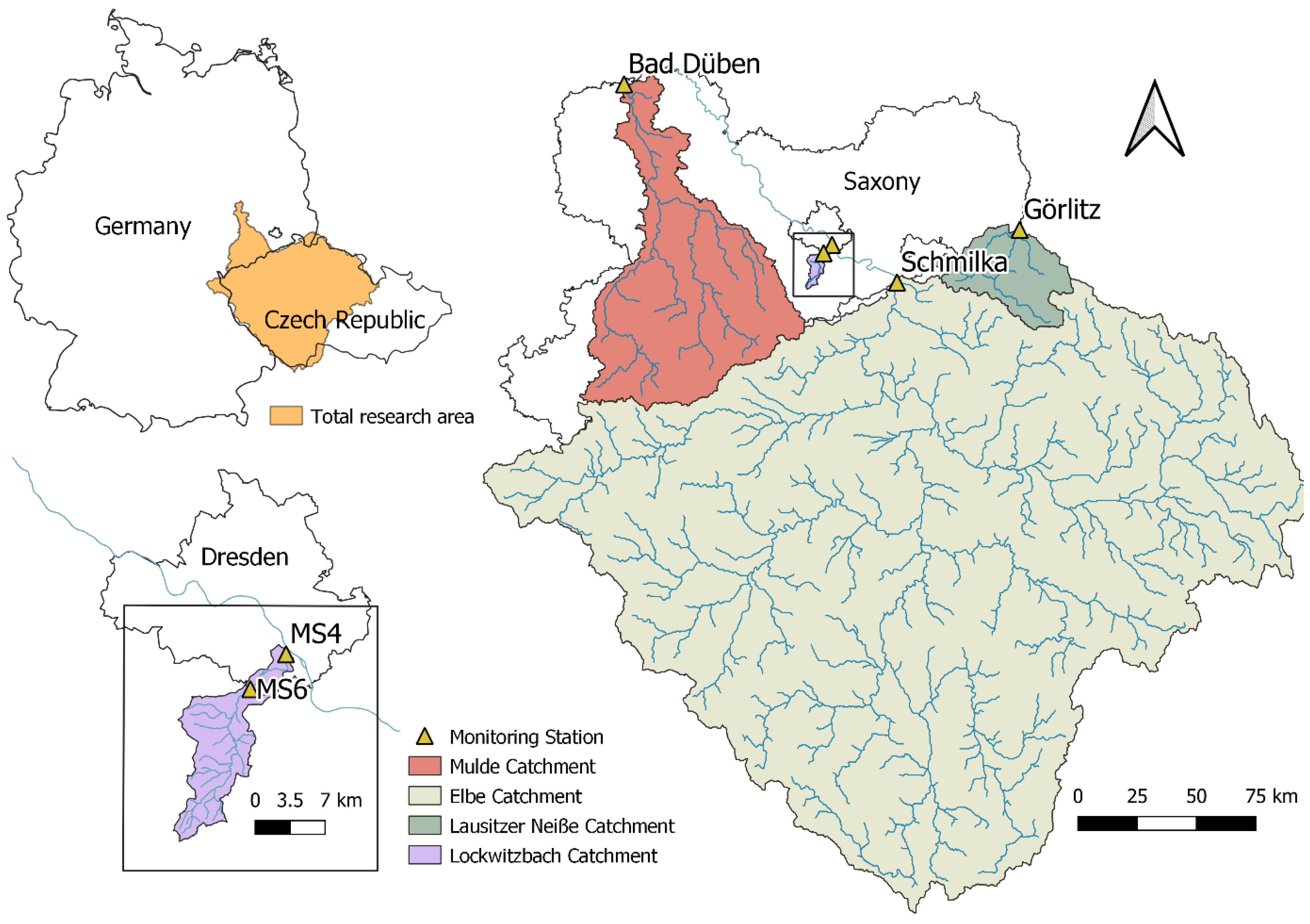


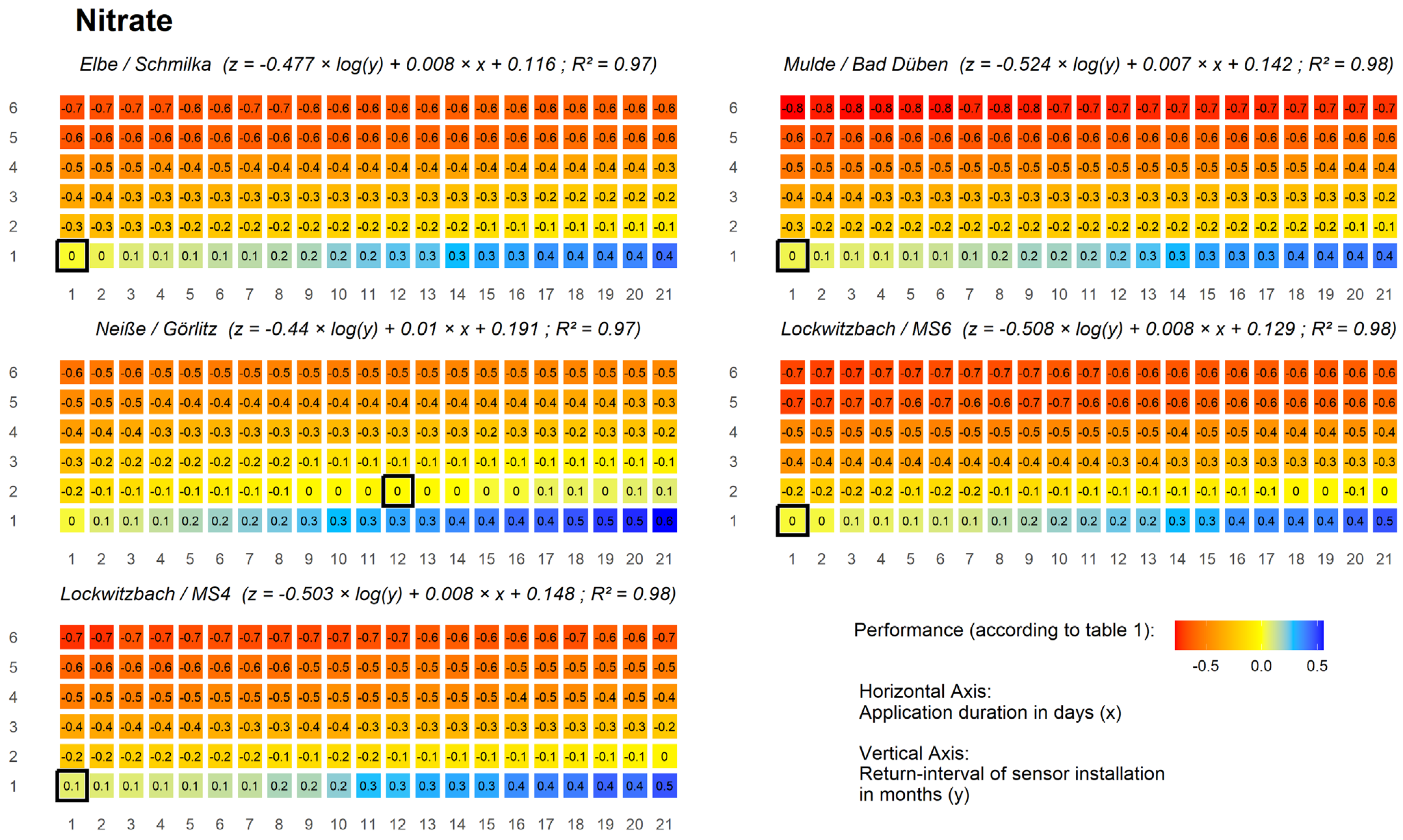


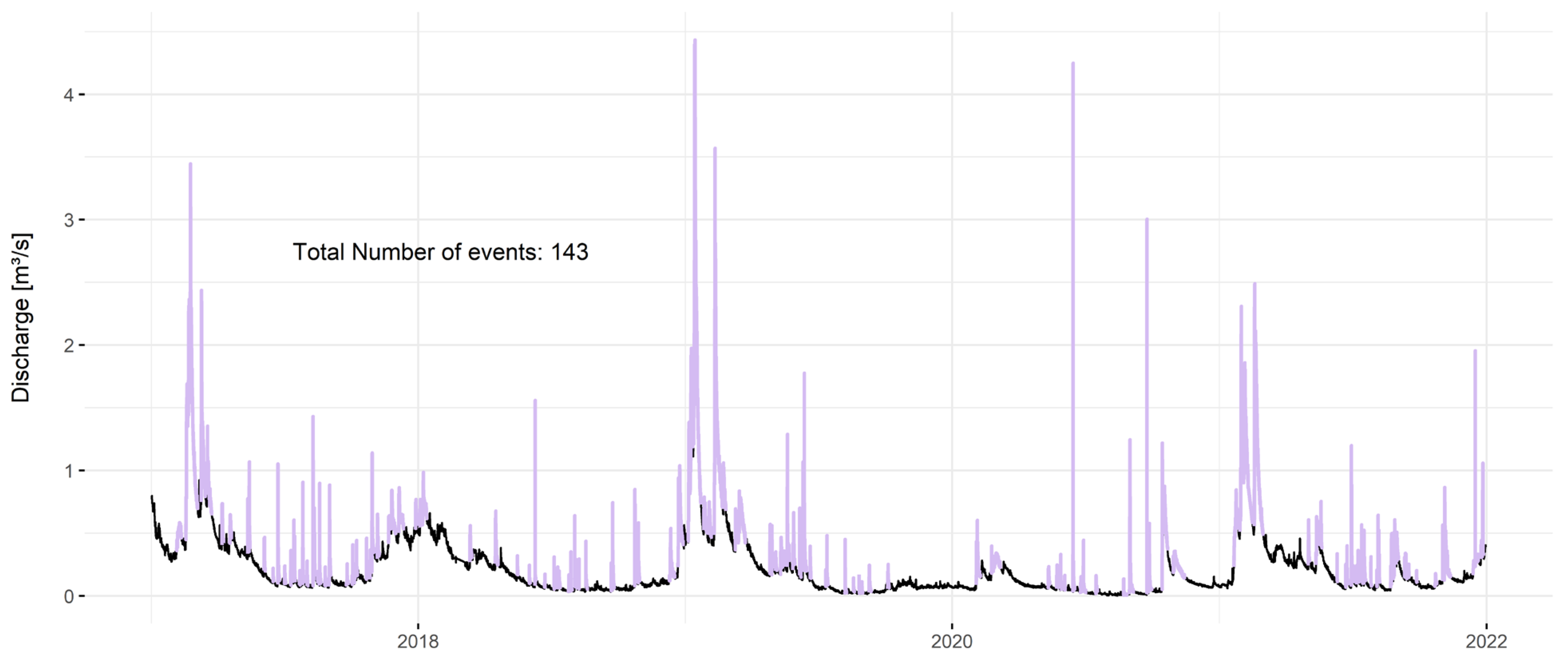

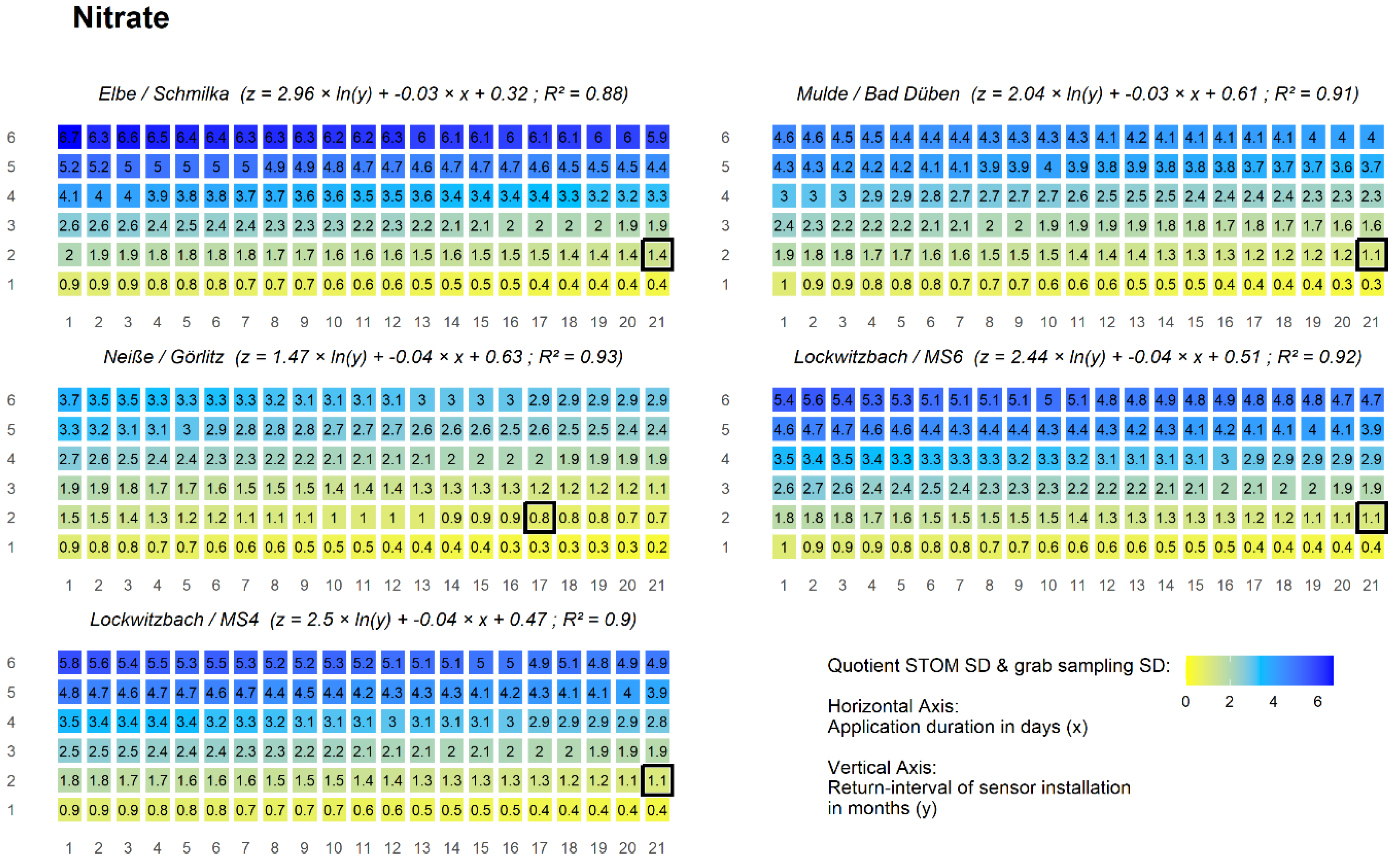

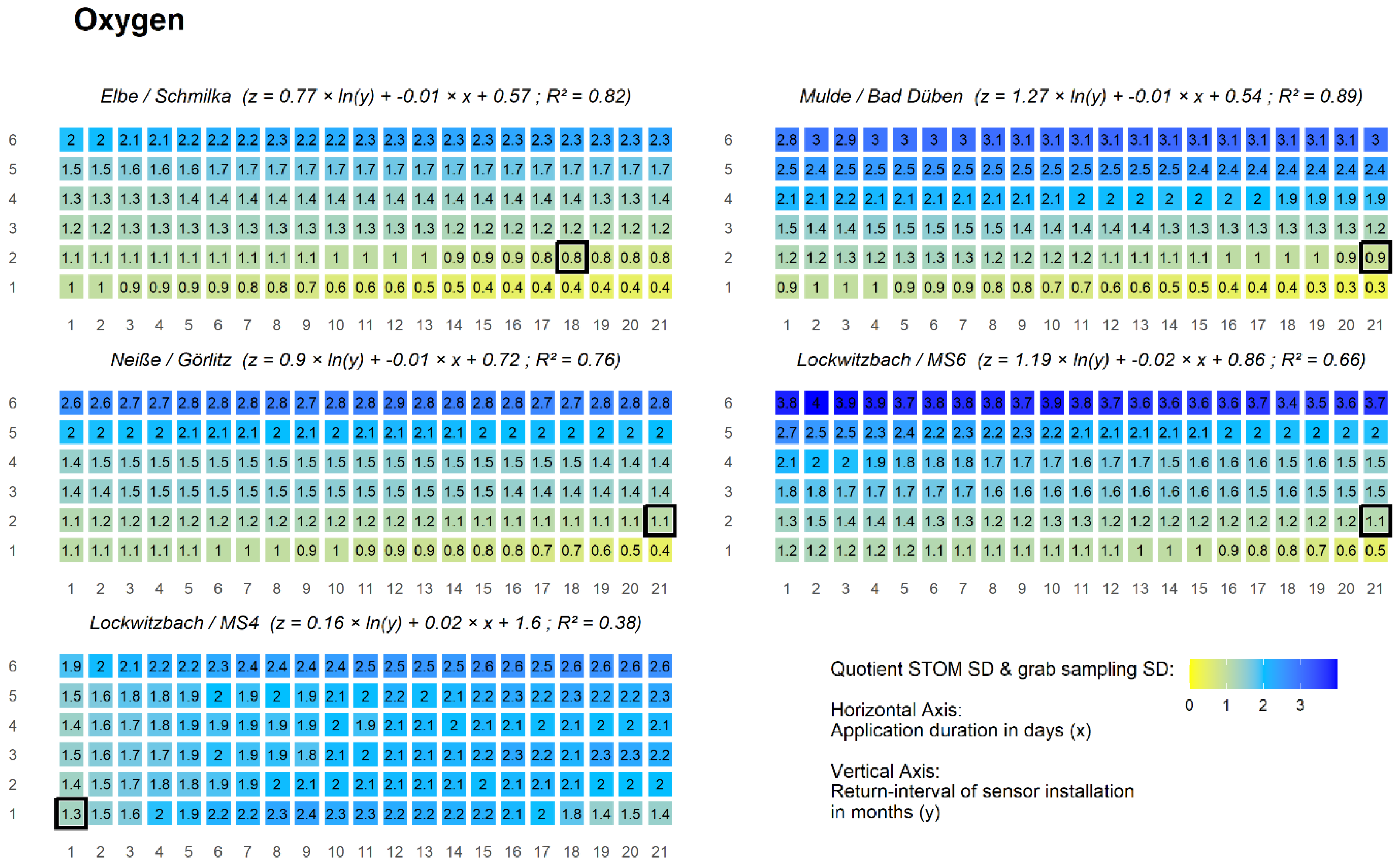
| Station | Catchment | Drainage Area [km2] | Land Cover Type (%) | BFI | ||
|---|---|---|---|---|---|---|
| Settlements | Agriculture and Pastures | Forest | ||||
| MS6 | Lockwitzbach | 73.3 | 9.2 | 72.8 | 18.0 | 0.71 |
| MS4 | Lockwitzbach | 84.0 | 18.0 | 67.5 | 14.5 | 0.70 |
| Görlitz | Lausitzer Neisse | 1632.7 | 13.0 | 51.0 | 35.0 | 0.81 |
| Bad Düben | Vereinigte Mulde | 6169.9 | 11.8 | 55.7 | 32.0 | 0.78 |
| Schöna | Elbe | 51,391.0 | 6.4 | 54.9 | 37.6 | 0.77 |
| NO3-N [mg/L] | Cl [mg/L] | O2 [mg/L] | ||||||||||
|---|---|---|---|---|---|---|---|---|---|---|---|---|
| Summer | Winter | Summer | Winter | Summer | Winter | |||||||
| Day | Night | Day | Night | Day | Night | Day | Night | Day | Night | Day | Night | |
| Schmilka/Elbe | 3.1 ± 0.8 | 3.1 ± 1.1 | 4.9 ± 1.1 | 4.9 ± 1.1 | 41.4 ± 8.4 | 40.7 ± 10.5 | 40.6 ± 10.5 | 40.6 ± 10.5 | 9.4 ± 1.8 | 9.3 ± 1.3 | 11.8 ± 1.3 | 11.8 ± 1.2 |
| Bad Düben/Mulde | 2.8 ± 0.6 | 2.8 ± 0.9 | 3.6 ± 0.9 | 3.6 ± 0.9 | 29.7 ± 4.5 | 29.4 ± 4.4 | 30.1 ± 4.4. | 30.5 ± 4.4 | 8.3 ± 1.8 | 8.5 ± 1.5 | 11.7 ± 1.6 | 11.7 ± 1.6 |
| Görlitz/Neiße | 2.4 ± 0.5 | 2.4 ± 0.7 | 3 ± 0.7 | 3 ± 0.7 | 37.2 ± 10.9 | 36.8 ± 10.4 | 34 ± 10.4 | 33.5 ± 10.6 | 8.4 ± 1.1 | 8.1 ± 1.3 | 11.8 ± 1.3 | 11.6 ± 1.3 |
| MS6/Lockwitzbach | 5.8 ± 0.9 | 5.7 ± 2.3 | 7.9 ± 2.3 | 7.8 ± 2.3 | 44.7 ± 9.1 | 44.7 ± 12.2 | 41.4 ± 12.2 | 41.3 ± 12.3 | 9.7 ± 0.8 | 9.2 ± 1.2 | 12.1 ± 1.2 | 11.7 ± 1.3 |
| MS4/Lockwitzbach | 4.7 ± 1.4 | 4.6 ± 2.5 | 7.5 ± 2.6 | 7.5 ± 2.5 | 44.6 ± 9.4 | 43.7 ± 12.3 | 39.9 ± 12.3 | 39.6 ± 12.3 | 10.5 ± 2.3 | 7.7 ± 1.9 | 12.9 ± 1.9 | 11.2 ± 1.7 |
Disclaimer/Publisher’s Note: The statements, opinions and data contained in all publications are solely those of the individual author(s) and contributor(s) and not of MDPI and/or the editor(s). MDPI and/or the editor(s) disclaim responsibility for any injury to people or property resulting from any ideas, methods, instructions or products referred to in the content. |
© 2024 by the authors. Licensee MDPI, Basel, Switzerland. This article is an open access article distributed under the terms and conditions of the Creative Commons Attribution (CC BY) license (https://creativecommons.org/licenses/by/4.0/).
Share and Cite
Benisch, J.; Helm, B.; Chang, X.; Krebs, P. Can Short-Term Online-Monitoring Improve the Current WFD Water Quality Assessment Regime? Systematic Resampling of High-Resolution Data from Four Saxon Catchments. Water 2024, 16, 889. https://doi.org/10.3390/w16060889
Benisch J, Helm B, Chang X, Krebs P. Can Short-Term Online-Monitoring Improve the Current WFD Water Quality Assessment Regime? Systematic Resampling of High-Resolution Data from Four Saxon Catchments. Water. 2024; 16(6):889. https://doi.org/10.3390/w16060889
Chicago/Turabian StyleBenisch, Jakob, Björn Helm, Xin Chang, and Peter Krebs. 2024. "Can Short-Term Online-Monitoring Improve the Current WFD Water Quality Assessment Regime? Systematic Resampling of High-Resolution Data from Four Saxon Catchments" Water 16, no. 6: 889. https://doi.org/10.3390/w16060889
APA StyleBenisch, J., Helm, B., Chang, X., & Krebs, P. (2024). Can Short-Term Online-Monitoring Improve the Current WFD Water Quality Assessment Regime? Systematic Resampling of High-Resolution Data from Four Saxon Catchments. Water, 16(6), 889. https://doi.org/10.3390/w16060889







